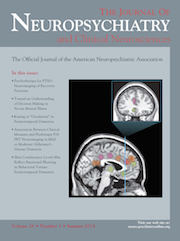The Relief of Leukocytopenia Within 1 Month After Switching Risperidone to Amisulpride
To the Editor: Leukocytopenia is not an uncommon side effect of antipsychotics. Here is a case report of a patient with risperidone-related leukocytopenia side effects, who had significant increase of white blood cells (WBC) after switching to amisulpride within 1 month.
Case Report
Mr. H is a chronic case with paranoid schizophrenia for 20+ years. He was treated with several typical antipsychotics (haloperidol and clopenthixol) in a long-term care unit, and he still had residual psychotic symptoms in the last 5–6 years. The symptoms included delusion of religion, delusion of persecution, auditory hallucination, voice commanding and commenting [Brief Psychiatric Rating Scale-18 items (BPRS-18) scores: 44, especially in items of uncooperativeness (6 points), hallucinatory behaviors (7 points), and suspiciousness (6 points)]. Thereafter, he used risperidone 6 mg/day but still without significant response of psychotic symptoms (BPRS-18 scores: 46). Furthermore, leukocytopenia side effects were observed (WBC: 2100/ul). He even tried high protein and high calorie diet under the suggestion of a dietitian. However, his leukocytopenia side effects were still not relieved under the above diet for 2 weeks (WBC: 2200/ul). He also received a consultation form a hematologist; no significant abnormalities of bone marrow were suggested. Therefore, risperidone (6 mg/day) was switched to amisulpride (800 mg/day) because of resistance to leukocytopenia. After the use of amisulpride, the WBC started to increase as observed seen at weekly check-ups (2900/ul ≥ 3100/ul ≥ 3500/ul ≥ 4800/ul). No significant side-effects after switching to amisulpride were observed. His psychotic symptoms also responded with less hallucinatory behaviors (BPRS-18 scores: 37).
Discussion
There are several published case reports that mention possible leukocytopenia or neutropenia side effects of risperidone.1, 2 However, Mahmood et al. suggested that risperidone can restore blood dyscrasia induced by phenothiazine and butyrophenone, typical antipsychotics. 3 In a German national study, leukocytopenia seems to be mostly induced by clozapine (0.18% patients exposed) and olanzapine/risperidone at lower proportions. 4 Apart from clozapine, olanzapine, and risperidone, there is also a case report of quetiapine-related leukocytopenia.5 It suggests that most second-generation antipsychotics still have the risk for leukocytopenia. For the amisulpride-related leukocytopenia, just one case report suggested the possible risk of leukocytopenia induced by amisulpride can be relieved by aripiprazole.6 The relatively pure dopamine-affinity profile for amisulpride or aripiprazole might be a possible mechanism for lowering the risk of leukocytopenia or neutropenia. Furthermore, these antipsychotics have been reported to be associated with increased number of immature neutrophils. Typical antipsychotics and risperidone seem to be associated with higher risk of left shift sign of WBC than sulpiride 7. The study also supported the rationale of switching to amisulpride for patients who suffered from leukocytopenia side-effects under the use of other antipsychotics.
1 : Risperidone-induced leucopenia and neutropenia. Br J Psychiatry 1997; 171:393–394Crossref, Medline, Google Scholar
2 : Risperidone/paliperidone induced neutropenia and lymphopenia. Aust N Z J Psychiatry 2013; 47:291–292Crossref, Medline, Google Scholar
3 : Risperidone appears safe in patients with antipsychotic-induced blood dyscrasias. Int Clin Psychopharmacol 1996; 11:53–54Crossref, Medline, Google Scholar
4 : Blood dyscrasias induced by psychotropic drugs. Pharmacopsychiatry 2004; 37(Suppl 1):S70–S78Crossref, Medline, Google Scholar
5 : Quetiapine-induced leucopenia and thrombocytopenia. Psychosomatics 2007; 48:530–531Crossref, Medline, Google Scholar
6 : Is aripiprazole the only choice of treatment of the patients who developed anti-psychotic agents-induced leucopenia and neutropenia? A case report. J Psychopharmacol 2008; 22:333–335Crossref, Medline, Google Scholar
7 : Formation of immature neutrophil leucocytes in schizophrenic patients treated with various antipsychotic drugs: comparisons and predictions. J Psychopharmacol 2006; 20:824–828Crossref, Medline, Google Scholar



